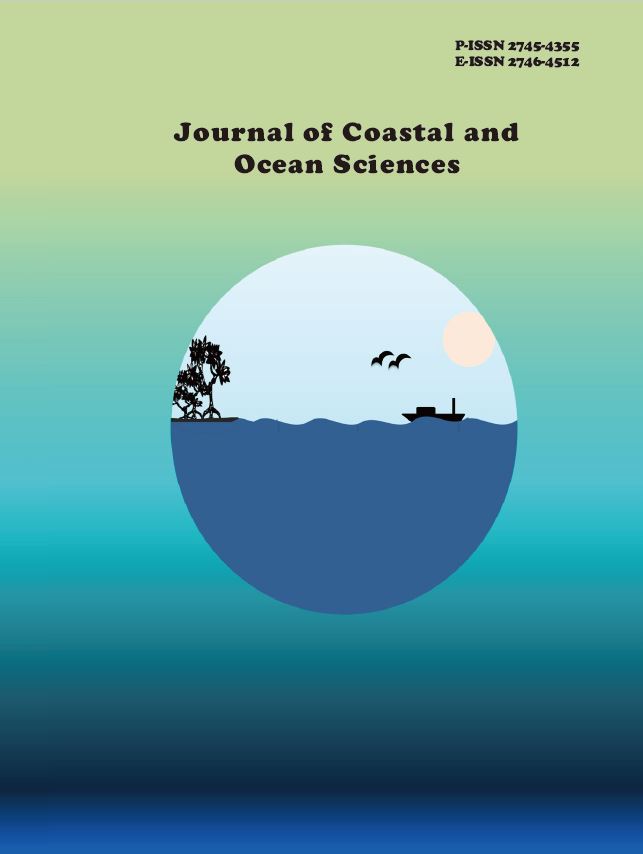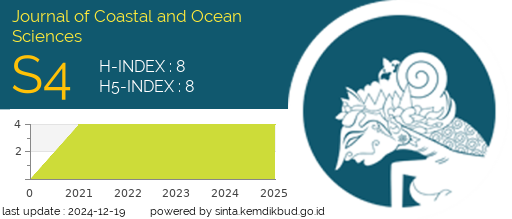Analysis of Environmental Conditions in Red-Eyed Snail Silvofishery in Buruk Bakul Village
DOI:
https://doi.org/10.31258/jocos.6.2.102-107Keywords:
Silvofishery, Buruk Bakul, Cerithidea obtusaAbstract
Buruk Bakul Village has a mangrove distribution covering approximately 168 hectares. However, coastal abrasion, which reaches an average of 4 meters per year, directly impacts biodiversity, including a decline in gastropod populations due to loss of shelter and food sources. One affected species is the red-eyed snail (Cerithidea obtusa), which plays a vital role in the food chain of coastal ecosystems. This study aims to determine the practice of silvofishery on C. obtusa and environmental quality, as well as changes in environmental quality due to silvofishery practices. Sampling technique: Sampling was done using the stratified random sampling method. The results showed that Silvofishery practices integrating mangrove conservation with red-eyed snail cultivation in Buruk Bakul Village showed varying results depending on environmental conditions. Plot 3 recorded the best growth with a length of 1.22 cm and a weight of 1.91 g, which was supported by the fine mud substrate and high organic matter content. In contrast, plot 1 showed the lowest results with a length of 0.77 cm and a weight of 0.48 g. Environmental conditions such as soil pH, temperature, and organic matter significantly influence snail growth, with soil pH and temperature as the dominant factors.
Downloads
References
[DKP] Dinas Kelautan dan Perikanan Kabupaten Bengkalis. (2022). Laporan Status Ekosistem Mangrove Kabupaten Bengkalis. Pemerintah Kabupaten Bengkalis. Riau. https://dkp.riau.go.id/.
Chau, N.D., Thao, N.T., & Nhan, D.K. (2007). Integrated Shrimp-Mangrove Farming Systems in the Mekong Delta of Vietnam. Aquaculture Research, 38(12): 1234-1242.
Effendie, M.I. (1979). Biologi Perikanan. Yayasan Pustaka Nusatama. Yogyakarta.
Febrita, E., & Trisnani, T. (2013). Kandungan Logam Berat Tembaga (Cu) pada Siput Merah (Cerithidea sp) di Perairan Laut Dumai Provinsi Riau. Biogenesis, 8(1): 36-40.
Kordi, M.G.H. (2010). Budi Daya Ikan di Tambak dan Keramba. Rineka Cipta. Jakarta.
Mashoreng, S., Hatta, M., & Rusti, R. (2022). Sediment Organic Matter Content Based on the Different Ages of Mangrove Vegetation in the Lantebung Mangrove Ecotourism Area, Makassar. Jurnal Ilmu Kelautan Spermonde, 8(1).
Purwaningsih, S. (2012). Antioxidant Activity and Nutrient Composition of Matah Merah Snail (Cerithidea obtusa)). Ilmu Kelautan: Indonesian Journal of Marine Sciences, 17(1): 39-48.
Samsumarlin, S., Rachman, I., & Toknok, B. (2015). Studi Zonasi Vegetasi Mangrove Muara di Desa Umbele Kecamatan Bumi Raya Kabupaten Morowali Sulawesi Tengah. Warta Rimba, 3(2): 148–154.
Soeharmoko, S. (2010). Inventarisasi Jenis Kekerangan yang Dikonsumsi Masyarakat di Kepulauan Riau. Jurnal Dinamika Maritim, 2(1):36-42.
Wijaya, N.I., Trisyani, N., & Sulestiani, A. (2019). Potensi Pengembangan Budidaya Silvofishery di Area Mangrove Wonorejo Surabaya. Penelitian Hutan dan Konservasi Alam, 16(2): 173-189.
Yunantri, M., Wahyuningsih, E., & Kresnasari, D. (2022). Pengaruh Faktor Lingkungan terhadap Keberadaan Gastropoda pada Ekosistem Mangrove di Dermaga Lantamal, Kelurahan Karang Indah, Distrik Merauke, Kabupaten Merauke. Musamus Fisheries and Marine Journal, 33-48
Downloads
Published
Issue
Section
License
Copyright (c) 2025 Gusnar Simangunsong, Budijono Budijono, Muhammad Fauzi (Author)

This work is licensed under a Creative Commons Attribution 4.0 International License.





